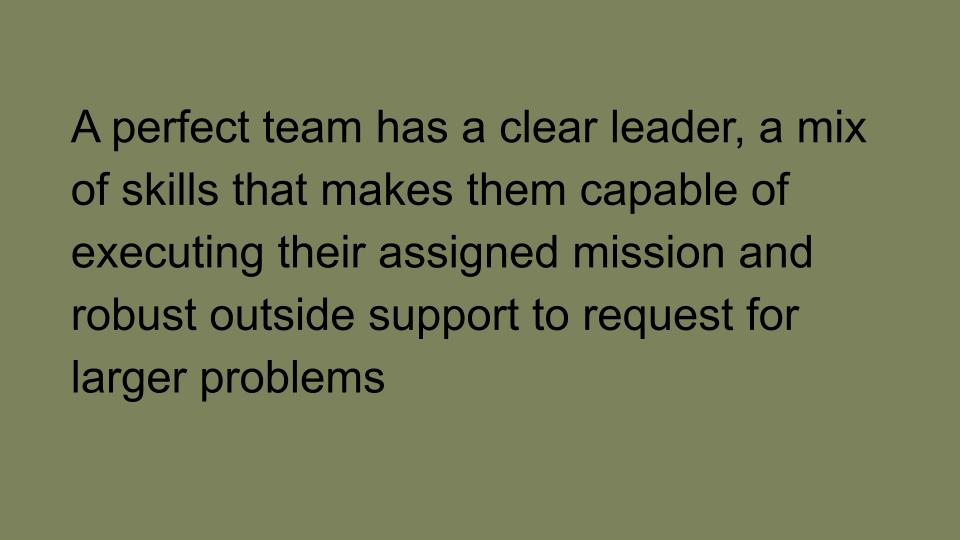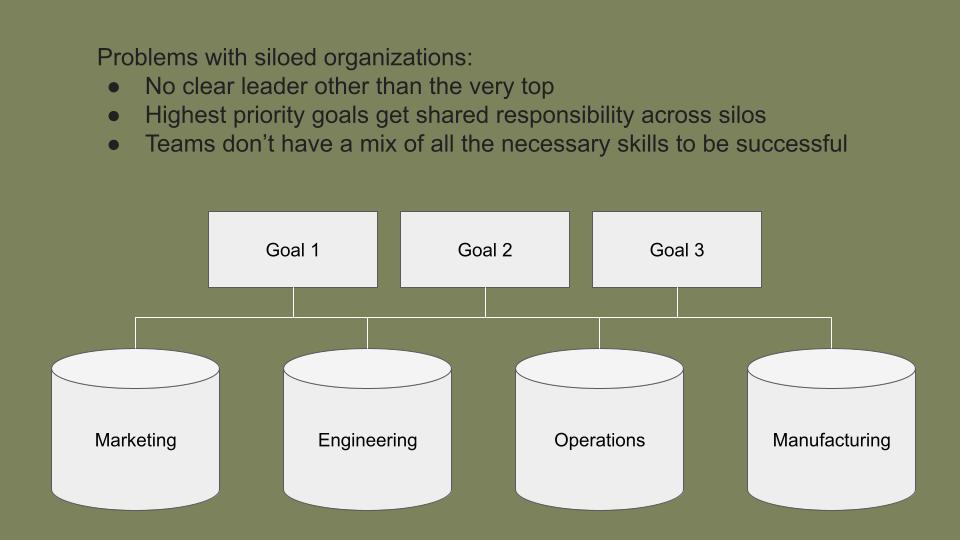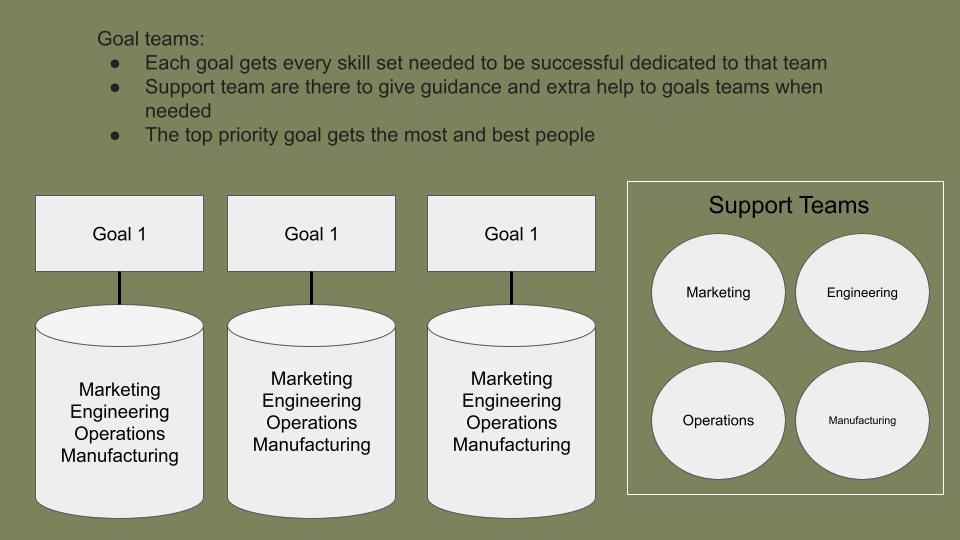SUMMARY:
-
Setup ‘goal teams’ that are dedicated to working on your companies most important goal
-
Those teams should have every person directly assigned that they need to be successful and report to a single responsible leader
WAR
Over the last 100 years the US military has been trying to determine the best strategy to set up their teams to win battles at every level. With the immediate feedback of loss of human life, there has been great urgency to get to the ideal state.
At the highest level, there are two fundamental things that every infantry team is set up to be successful in:
- Decentralized command – the team should be able to operate with a minimum level command direction and outside support.
- Combined arms dilemma – Teams of all sizes are capable of putting the enemy in the combined arms dilemma. It should increase in size with the unit to match the size of the enemy that unit would fight.
To accomplish these fundamentals, the Marine Corps has developed the following standards for their teams:
- The team is led by a single leader (unity of command).
- The team has the correct gear, weapons and skills to accomplish the mission at the lowest level (decentralized command and combined arms dilemma) .
- The team has direct access to specialized teams that help to deal with larger problems (large weapons / more logistics / communication specialist, etc.).
A perfect team has a clear leader, a mix of skills that makes them capable of executing their assigned mission and robust outside support that is available for larger problems.
A team should report to a single leader
Unity of command is one of the nine principles of war. It is the theory that overall responsibility should be assigned to a single person. This gives that person the authority to sequence and allocate everyone on a team to be most effective at achieving a goal.
The decision making needed to prioritize and to sequence resources is done best by a single responsible person.

If there isn’t a single leader, those decisions must be made by mutual agreement. This can be an impossible task. It also takes considerable time and effort to mutually agree on every decision as a leadership team.
It’s much more efficient to have a single leader who can take all of the inputs and drive the decision making.
Self sufficient teams
Every team needs a diverse skill set that allows them to solve a majority of their problems at their level.
To be self-sufficient the infantry needs these things:
- A mission with an understanding of the commander’s intent and desired end state
- Direct fire weapons (guns) and indirect fire weapons (grenades, mortars)
- The ability to communicate (radios, smoke, pyro / flares)
- Food, water and ammunition
- Attachments to deal with mission specific problems (engineers, trucks, vehicles, etc.)
- Marines who are physically and mentally tough, are experts in their gear, work as a team and have a single leader
If a team has everything listed above, then they can operate on their own and solve problems that are appropriate for their size.
Larger problem get more support
You can only expect a team to handle an enemy that is appropriate to their size. A platoon of forty Marines can not be expected to fight hundreds of enemy soldiers.
To deal with a larger number of enemy troops, the infantry setup must include larger and more capable teams.
From a fire team of four Marines to a regiment of thousands, each level is given escalating firepower to deal with increasingly complex problems.
Escalation the teams:
- The Marine Fire Team has M4 rifles, M67 fragmentation grenades and a M203 grenade launcher. This allows Marines to shoot bullets at the enemy, while they move close enough to shoot and throw grenades into the room or hole that the enemy is hiding in.
- A Company of infantry Marines includes about 150 Marines and has even more assets. They have the M240B medium machine gun which increases the fire power of the direct fire weapon, MK153 SMAW rocket launcher and M224 60MM mortar system. These are much larger, more powerful direct (machine gun and rocket launcher) and indirect (mortar system) weapons that increase a company’s ability to deal with bigger problems.
- A battalion of infantry Marines with between 500 and 1000 Marines has the ability to cause an even bigger combined arms dilemma. They have M2 .50 caliber, MK19 40mm heavy machine guns and M252 81MM mortars. They are bigger and more powerful than what the company has.
- The Marine regiment, which has thousands of Marines, has even bigger weapons attached to them. Regiment usually have a 155MM howitzer artillery cannon and HIMARs rockets, a as well as fixed and rotary wing air assets.
The combination of direct fire and indirect fire weapons wins battles. The bigger the battle, the bigger the assets needed to fight it. This is translated into how they equip and train their teams. They give every single infantry Marine the ability to inflict the combined arms dilemma.
The smallest unit is as self-sufficient as possible. If they run into a problem that is too big for them to deal with, they have access to support which will help them overcome it. This applies to communication, logistics, or enemy problems.
Specialized teams specific support
There are many problems in addition to the enemy that the infantry has to deal with. For those problems, there are specialized Marines who focus on solving these problems. A few examples of these Marines would be communication, intelligence, logistics and administration.
These specialized Marines are employed in two ways.
First, there are a contingent of these Marines who work directly for the infantry commanders. For communication, every company and battalion commander has Marines who are highly trained in radio communication. These Marines work directly for the commander and which allows direct prioritization. These Marines can handle the vast majority of the communication problems with no outside support. The communication Marines work directly for the commander for both tasking and performance.
Second, if the Marines who work for the commander don’t meet the requirements, there are larger and more capable teams that are available for support. These teams will work directly for the higher commander. This is similar to how the infantry has bigger and bigger weapons as the unit gets larger. The support Marines have larger and more capable teams who can help to overcome issues at the lower levels.
BUSINESS
There are three main takeaways that are useful for the business world. They are based on how the infantry sets up their teams.
- Give a team a mission and every skill needed to accomplish it.
- Have that team report to a single responsible person.
- Have clear support structures for the team if a problem is more serious than expected.
Businesses are generally set up in a manner that is the complete opposite of these principles.
Inefficient business reorganization
Most of the business world is poorly organized. Almost every organization is siloed into skill sets. These skill sets are turned into vertical organizations, such as marketing, finance, technology, engineering, manufacturing, operations, product, etc.
These vertical organizations result in everyone with many different bosses.They have their direct boss within their organization, with a similar skillset, who they care most about pleasing. There is also a boss who is responsible for the workstream they are working on. This could be a project team or some other dotted line relationships. Within these silos, everyone is assigned as many projects as possible. These projects involve many different teams. The people leading this work are project managers. They have no authority to actually lead the teams. They do it mostly by politely asking for help. They are then allocated scraps of time for everything people are doing.
This is very inefficient. It causes constant prioritization and unity of command problems.
The ideal strategy is to build teams that are based on the company’s most important goals. They should be staffed well, given the best leader with authority over the entire team and supported until the goal is accomplished.
Goal organization
Every team should be organized around a goal. These are called Goal Teams. The Goal Team should have every person who is needed directly on that team with a single leader. Everyone is pulled out of their silos and reports, on a performance and task basis, to a general goal leader. This means a marketer could report to an engineer or vice versa. The best leader for that goal is the leader.
There is no hard reporting relationship with the people in your previous silo. The team reports solely to a single leader who is completely responsible to lead the team to accomplish the goal.
The most important goals of the company would each get a Goal Team assigned, until the company runs out of goals or people. At the very least, the most important goal of the company should have a direct team assigned to it.

The Goals Team would be assigned specific goals based on the company’s priorities. They would ideally have no other responsibilities. The teams would be augmented or reduced based on the team’s workload.
The vision for this arrangement would be that each goal of the company has a full staff team that allows it to complete the work and independently solve problems. They should have the authority to dictate changes across the entire organization and to ask for help and get immediate assistance from any necessary personnel.
Clear support structure
In addition to the Goal Teams, there would be Headquarter teams that consist of the company’s general silos. They would be made up of the most senior people within that specialty. They would act as advisors and mentors to the Goals Teams. The headquarters teams would also advise the CEO on how to best distribute talent capacity within the Goal Teams.

The Headquarters Teams would be the support structure for the goal team if they can’t handle the problem on their own. For example, if the marketing teams get bogged down in their work towards the goal, they can escalate this to the larger teams who can support their work,
Sports team
It is instructive to examine how sports teams (such as basketball teams) are organized. They have five different players in the starting lineup. The players have different body types and skill sets, which allows them to perform all the needed tasks in the game. The entire team reports to one general leader, who is the head coach. Each position group will report to a position coach for help with a problem they are facing. There are also bench players who fill in, when needed.
Most companies are organized in a manner which is the complete opposite of sports teams. They are set up so that all the positions work mostly with the same positions. All the point guards only work with other point guards, all the centers only work with other centers, etc. If the centers need to work with the point guards, they go and ask the boss of the centers if that is what they want them to do. When all of the skill sets are working on a project together, the center is only allocated part time and has other higher priorities.
Imagine how bad a basketball team would be if they were set up like that.
The military is organized very similar to how sports teams are organized. They both get immediate hard feedback on whether they were successful This forces them to find the most efficient way to organize for success.
The business world has somehow figured this out. It’s likely because they don’t receive immediate feedback on their wins and losses. They can go months without realizing how poorly they are organized.
Conclusion
You should set up your teams so they have a single focus with every skill set on the team that is needed for success. Everyone should be pulled out of their silos, so they can report to a single leader both for tasking and performance. Team support should be provided for any problems that are too large for them to handle on their own. If you do that for at least your most important goals, they will get accomplished.

0 Comments